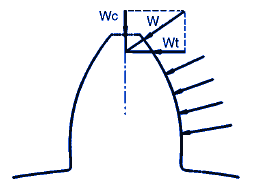Gear Tooth Strength Calculator
The following is an engineering calculator for determining or estimating your required gear tooth strength.
To see the equation behind this calculator see:
Gear Tooth Strength Calculation and Equation

Where:
W = Maximum transmitted load (lbs, N)
S = Maximum bending tooth stress taken as 1/3 of the tensile strength (psi, N/mm2)
F = Face width of gear (in, mm)
DP = Diametral Pitch, (in, mm).
Y = Lewis Factor (See Lewis Factor for Gears) (no units)
t = number of teeth, #
pd = pitch circle of gear teeth (in, mm)
The conversion formula for the module (m) from the diametral pitch (DP) is as follows:
m = 25.4 /DP
A gear or cogwheel is a rotating machine part having cut teeth, or cogs, which mesh with another toothed part in order to transmit torque, in most cases with teeth on the one gear being of identical shape, and often also with that shape on the other gear. Two or more gears working in tandem are called a transmission and can produce a mechanical advantage through a gear ratio and thus may be considered a simple machine. Geared devices can change the speed, torque, and direction of a power source. The most common situation is for a gear to mesh with another gear; however, a gear can also mesh with a non-rotating toothed part, called a rack, thereby producing translation instead of rotation.
The gears in a transmission are analogous to the wheels in a crossed belt pulley system. An advantage of gears is that the teeth of a gear prevent slippage.
When two gears mesh, and one gear is bigger than the other (even though the size of the teeth must match), a mechanical advantage is produced, with the rotational speeds and the torques of the two gears differing in an inverse relationship.
In transmissions which offer multiple gear ratios, such as bicycles, motorcycles, and cars, the term gear, as in first gear, refers to a gear ratio rather than an actual physical gear. The term is used to describe similar devices even when the gear ratio is continuous rather than discrete, or when the device does not actually contain any gears, as in a continuously variable transmission.
Reference
1. Earle Buckingham, Manual of Gear Design",3 Vols., Industrial Press, New York, 1935
2. Chironis, N.P.(Editor): "Gear Design and Application", McGraw-Hill Book Co., Inc. New York, NY., 1967
3. D.W. Dudley, "Gear Handbook", McGraw-Hill, NewYork,1962
4. Knut 0. Kverneland (Editor), "World Metric Standards for Engineering", Industrial Press, New York, NY. 1978
5. G.W. Michalec,"Precision Gearing: Theory and Practice", John Wiley & Sons, New York, 1966
6. J.E. Shigley,"Mechanical Engineering Design", McGraw-Hill, New York, 1963
7. W. Steeds,"Involute Gears, Longmans, Green and Co., London, 1948
8. El. DuPont de Nemeurs and Co., "Gears of DELRIN and ZYTEL'", Wilmington, Delaware.
9. Celanese Plastics and Specialties Co., "Design and Production of Gears in CELCON Acetal Copolymer", Chatham, New Jersey,
1979
10. The Polymer Corp, "Nylatron Nylon Gear Design Manual', Reading, Pa.
11. L.D. Martin, "Injection Molded Plastic Gears",
Plastic Design and Processing Magazine , Pt.1 ,pp. 38-45. August 1968.
12. E.l. DuPont de Nemours and Co.. DELRIN Design Handbook", Willinggton. Delaware, 1967
13. Clifford E. Adams, "Plastie Gearing" Marcel Dekker, Inc. New YorK 1986 -
Related:
- AGMA Contact Stress Number Formula for Gear Tooth Equation and Calculator Per standard ANSI/AGMA D04 Fundamental Rating Factors and Calculation Methods for Involute Spur and Helical Gear Teeth:
- AGMA Gear Tooth Bending Stress Formula and Calculator Per standard ANSI/AGMA D04 Fundamental Rating Factors and Calculation Methods for Involute Spur and Helical Gear Teeth:
- Gear and Tooth Component Illustration A gear or cogwheel is a rotating machine part having cut teeth, or cogs, which mesh with another toothed part in order to transmit torque.
- Gear Equations, Calculators and Formula Spur Gear design formula for geometry, pitch, tooth clearance and critical functional data.
- Gear Terminology and Definitions Backlash is the amount by which the width of a tooth space exceeds the thickness of the engaging tooth on the pitch circles.
- Hertz Gear Tooth Contact Stress Equation and Calculator The transfer of power between gears takes place at the contact between the acting teeth. The stresses at the contact point can be computed by means of the theory of Hertz.